It is easy to identify columnar cacti. They are tall cacti with one single main stem and arms branching from the sides.
Columnar cacti can be the “arborescent” type, which can be tall like a tree with one clearly visible main stem and arms growing well above ground from the main stem.
Columnar cacti can also be the “shrubby” type, which is shorter than arborescent cacti with arms developing close to the base of the plant.
Arborescent Columnar Type
1. San Pedro Cactus (Echinopsis pachanoi)
San Pedro Cactus can grow 10 – 20 feet (3 – 6 meters) in height and has vertical ribs upon which thick, sharp spines grow.
Its flowers only last for about 2 days during the spring, blooming at night.
It is fast-growing and is used in traditional medicine throughout the world.
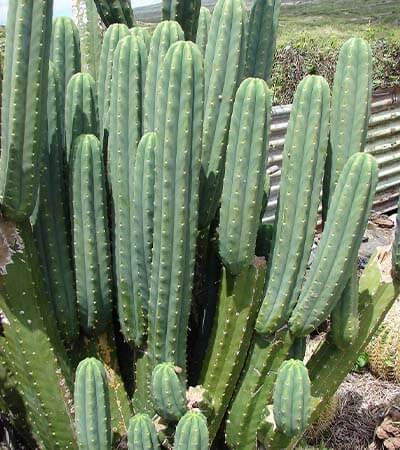
(Forest & Kim Starr, CC BY 3.0, via Wikimedia Commons)
2. Baseball Bat Cactus (Neoraimondia Herzogiana)
The Baseball Bat Cactus is named for its unique shape: The single columnar stem is narrow at the base and becomes wider as it grows up. The top is wide and rounded like the end of a baseball bat.
Long, sharp spines – often reaching as long as 2 inches (5 cm) – grow in dense clusters along the ribs of this cactus.
Arms rarely grow from the thick, columnar stem.
It is a slow-growing cactus, though it often reaches heights of 40 feet (12 meters) and will produce pink flowers every year during the winter.
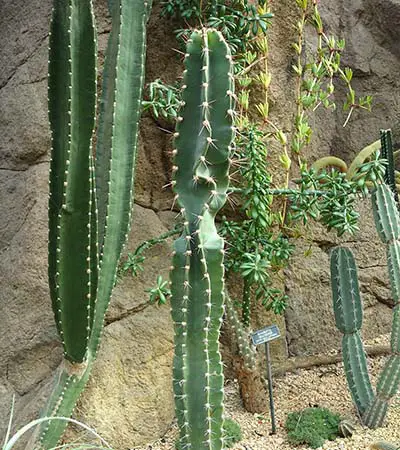
(Daderot, CC0, via Wikimedia Commons)
3. Snow White Prickly Pear (Opuntia erinacea ursine)
This unusual species of prickly pear has elongated, narrow-tipped pads with soft white hairs that give it a fuzzy appearance.
It grows more upright than other prickly pear varieties and can become 5 feet (1.5 meter) tall and 4 feet (1.2 meter) in width.
The Snow White Prickly Pear, like other prickly pear species, is more tolerant to cold than other cactus varieties and can grow as far north as the Rocky Mountains.
4. Saguaro (Carnegiea gigantea)
Arguably the best-known cactus in the Sonoran Desert and the largest cactus native to the US, the Saguaro can reach towering heights of 50 feet (15 meters) tall.
A single Saguaro can develop up to 25 arms, while some never develop arms.
Saguaro cacti can live between 100 to 200 years old.
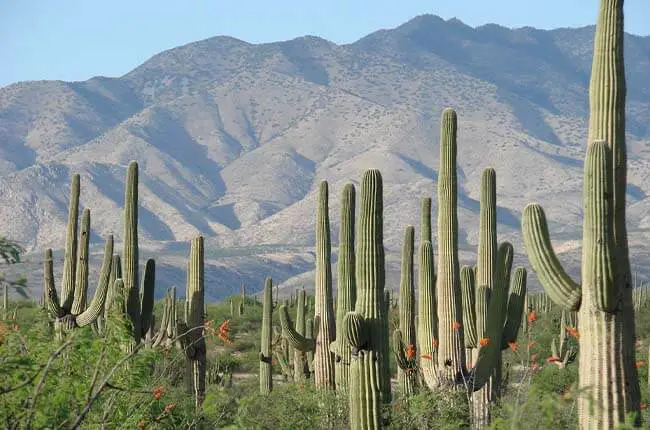
(Tyrv, CC BY-SA 4.0, via Wikimedia Commons)
5. Mexican Organ Pipe (Stenocereus griseus)
The Mexican Organ Pipe is a large, tree-like cactus with long, stiff white spines that grow along its ribs.
It can grow up to 30 feet (9 meters) in height with multiple arms that measure 5 inches (12 cm) in diameter.
It produces trumpet-shaped purple and white flowers during the spring and tasty, edible fruit that is often used in jams, jellies, or eaten raw
Other names for this unique cactus include the Dagger Cactus, Pitayo, and Pitayo de Mayo.
It is native to the Caribbean and South America.

(Scott Zona from Miami, Florida, USA, CC BY 2.0, via Wikimedia Commons)
6. Old Man Cactus (Cephalocereus senilis)
The Old Man Cactus is hairy cactus with a thick layer of white wool that makes this plant resemble an old man’s beard.
It can grow up to over 33 feet (10 meters) tall.
Older cacti grow arms high up the main stem while some may not grow any arms. Some of the oldest Old Man cacti have lived up to 200 years old.
It produces red or yellow flowers that bloom at night during the summer months.
It is native to Central Mexico.
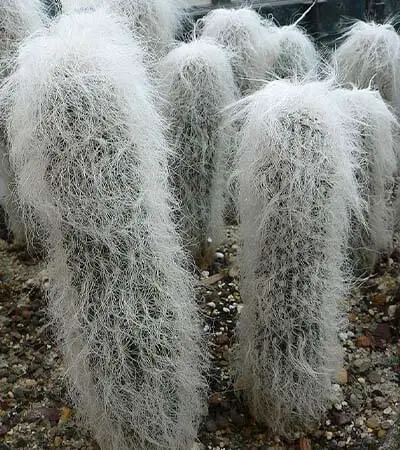
7. Joshua Tree (Yucca brevifolia)
This Joshua Tree cactus is known for its single woody trunk, with long arms branching off at the top of the trunk and each sporting long, sharp, and pointed leaves.
Soft, papery brown or tan leaves cover the trunk, and creamy white flowers grow in tight clusters from the topmost branches.
The Joshua Tree can grow up to 45 feet (14 meters) tall.
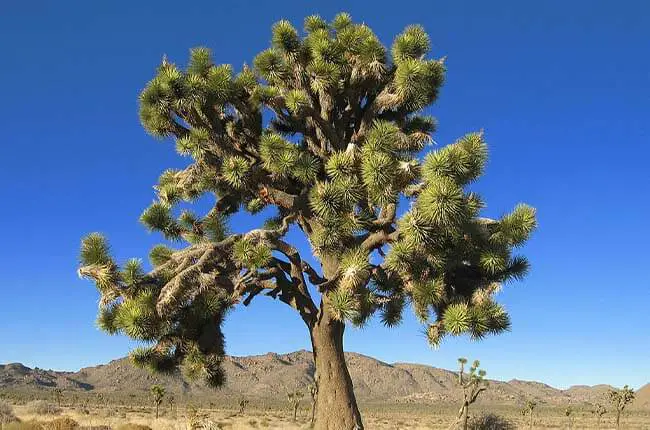
(Robb Hannawacker, while working for Joshua Tree National Park, Public domain, via Wikimedia Commons)
Shrubby Columnar Type
8. Buckhorn Cholla (Cylindropuntia acanthocarpa)
Cholla cacti are some of the best examples of shrubby columnar cacti, with columnar tubercules, branching out like antlers
It has sharp, bristly spines, and produces bright yellow or magenta cup-shaped flowers during the spring.
It is native to the Mojave and Sonoran deserts in the southwest US and northern Mexico.
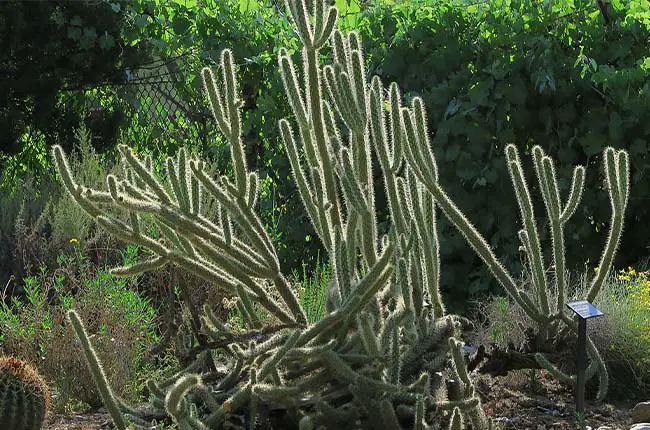
(John Rusk from Berkeley, CA, United States of America, CC BY 2.0, via Wikimedia Commons)
9. Blue Myrtle Cactus (Myrtillocactus geometrizans)
This charming cactus is named for its signature bluish silver color.
Sharp white spines grow in dense clusters along its vertical ribs, while the cactus flesh between the ribs is smooth and waxy. The Blue Myrtle Cactus is tall, growing between 10 – 15 feet (3 – 4 meters) in height.
Young Blue Myrtle Cacti are shrubby, growing several nodules close to the base, while mature cacti branch out high on a single stem.
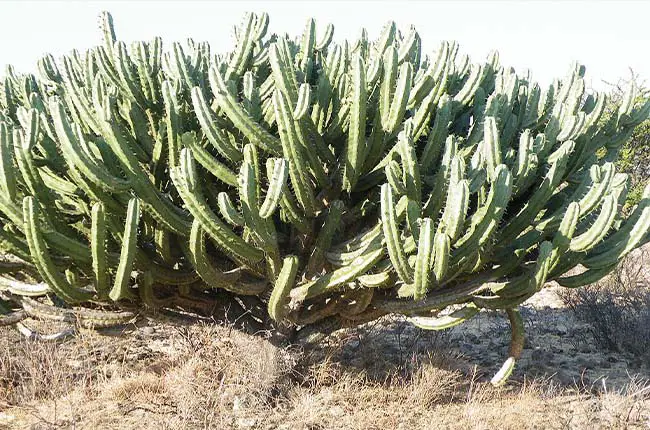
(Amante Darmanin from Malta, CC BY 2.0, via Wikimedia Commons)
10. Silver Cholla (Cylindropuntia echinocarpa)
This large, woody, shrub-like cactus has many branches with long, dense yellow spines. The nodules grow in clusters from each joint.
The Silver Cholla can grow up to 6 – 10 feet (1.8 – 3 meters) tall and 5 – 6 feet (1.8 meter) wide.
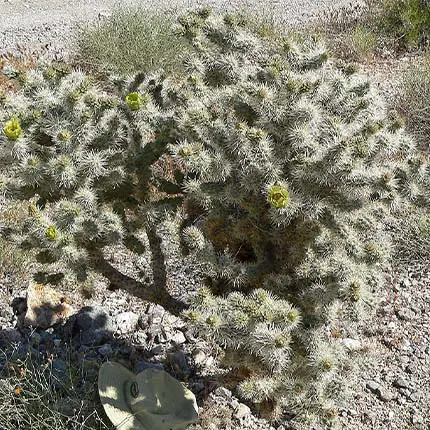
(Stan Shebs, CC BY-SA 3.0, via Wikimedia Commons)
11. Cane Cholla (Cylindropuntia imbricata)
The Cane Cholla has one of the widest distributions of the cholla cacti, growing as far south as northern Mexico and as far north as the Rocky Mountains in Colorado.
This shrubby, woody cactus grows more upright than some other cholla species and produces large round magenta blossoms in the spring.
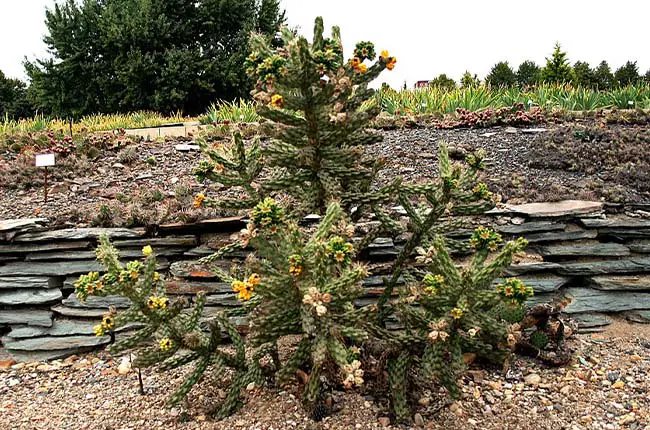
(Karelj, Public domain, via Wikimedia Commons)
12. Pencil Cactus (Cylindropuntia leptocaulis)
The unique, slender shape of this cactus’ branches lend it its common name.
New stems – each roughly the diameter of a pencil – sprout and flower during the winter months, producing round red edible fruit.
This shrubby cactus can reach heights of 6 feet (180 cm).
The Pencil Cactus – also called the Pencil Cholla – is native to Texas and the southwestern US.

(Patrick Alexander from Las Cruces, NM, CC0, via Wikimedia Commons)
13. Fairy Castle Cactus (Acanthocereus tetragonus)
Named for their unusual growing pattern which resembles the densely clustered towers of a Medieval castle, the Fairy Castle Cactus is a medium green cactus that produces asymmetrical tubercules that grow in a variety of angles.
Its short, soft spines grow infrequently, and the cactus can reach a height of 6 feet (180 cm), but it is very slow growing and may only grow a few inches in the course of a year.
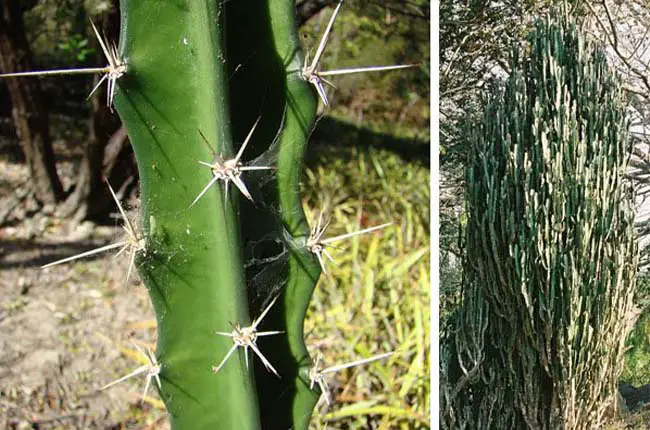
(Dick Culbert, CC BY 2.0, via Wikimedia Commons)
14. Organ Pipe Cactus (Stenocereus thurberi)
This stately columnar cactus species can grow as tall as 16 – 26 feet (5 – 8 meters). Several columns grow from a single point near the base and arms branch out near the tops of each column.
The Organ Pipe Cactus blooms at night and is pollinated by bats, producing large, round, bright yellow flowers.
It is native to the Sonoran Desert and is one of the largest cacti native to the Sonoran Desert.
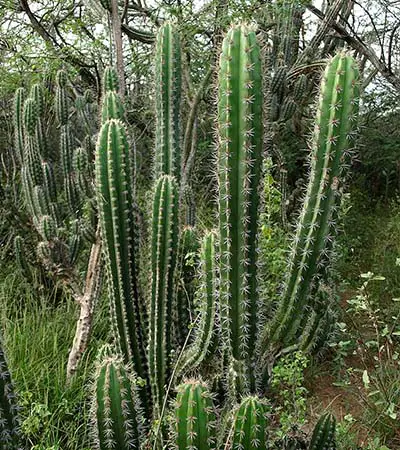
(Pretzelpaws at English Wikipedia., CC BY-SA 3.0, via Wikimedia Commons)
15. Beavertail Prickly Pear Cactus (Opuntia basilaris)
Native to the Mojave Desert, Beavertail Prickly Pear produces flattened, ovaloid pads from which round, purple or red fruit grow in the summer.
Prickly pear fruit is commonly used for jams, candies, or eaten raw.
The cactus grows about 2 feet (60 cm) tall and as wide as 4 – 6 feet (120 – 180 cm).
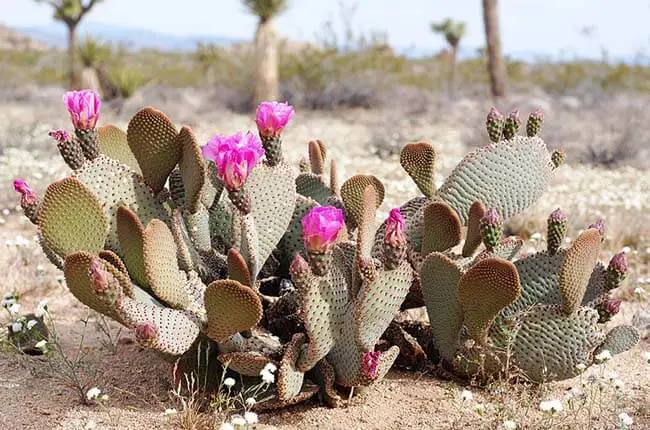
(Jarek Tuszyński / CC-BY-SA-3.0, CC BY-SA 3.0, via Wikimedia Commons)
16. Ocotillo Cactus (Fouquieria splendens)
Prized for their lovely red clusters of flowers at the ends of their stems, the Ocotillo Cactus has long, skinny tubercules that branch out from a single point near the base.
These tall stems can reach heights of 20 feet (6 meters) and have long, sharp spines.

(DiverDave, CC BY-SA 3.0, via Wikimedia Commons)
17. Key Tree Cactus (Pilosocereus robinii)
Native to the Caribbean and Florida Keys, the Key Tree Cactus is a shrub-like cactus that can grow to heights of 33 feet (1 meter) tall.
Thick, columnar nodules grow upwards and branch out while it produces white, green, or purple flowers that smell similar to garlic.

(Dick Culbert from Gibsons, B.C., Canada, CC BY 2.0, via Wikimedia Commons)
18. Night Blooming Cereus (Peniocereus greggii)
True to its name, this cactus produces showy, fragrant white flowers that bloom during the nighttime in late spring and early summer.
The cactus can grow up to 6 feet (180 cm) in height.
It is native to southern New Mexico, the Big Bend region of Texas, and Northern Mexico.
Related
13 Stunning Cacti by Flower Color
Top 10 Little-Known Spiral Cactus
- Top 6 Drip Irrigation Systems for Raised Beds (2025) - January 31, 2025
- Top 10 Orchid Fertilizers: A Comprehensive Review (2025) - January 16, 2025
- Top 6 Slow-Release Fertilizers for Houseplants & Veggies (2025) - January 15, 2025
